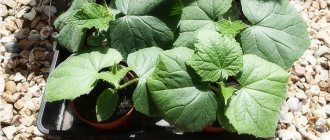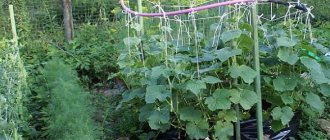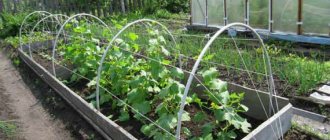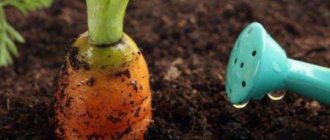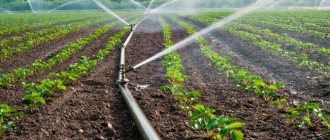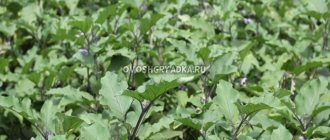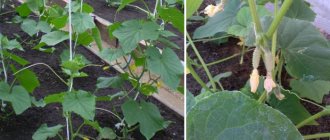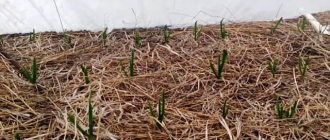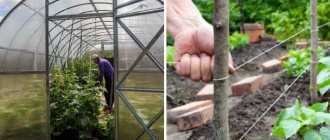The most important agricultural technique in caring for cucumbers is, oddly enough, watering.
Cucumber is the most important “water bread” among all vegetables. Compliance with the watering regime and rules is very important if you do not want to get bitter small greens. Dear readers!
For you, we have created communities on social networks in which useful articles and interesting ideas are published several times a day! Subscribe and receive useful content in a convenient format! In this article we will figure out how to properly water cucumbers that grow in open ground in the garden and in the greenhouse.
What kind of water do cucumbers like?
Cucumbers prefer settled warm water. The optimal temperature is within +20+24 degrees. The minimum permissible temperature is 16 degrees. You can allow the water to heat up a little more than optimal, but there is no need to use hot liquid either. In this regard, cucumber is a very finicky crop, which reacts equally capriciously to either too cold or too warm a liquid.
Thus, it turns out that water from a hose connected to a well or a central water supply system cannot be used to water cucumber bushes.
It's great if you have the ability to collect water when it rains. This liquid is best suited for cucumbers.
REFERENCE. Cold water provokes the fall of flower stalks and ovaries, as well as the development of cucumber diseases.
Diseases and pests of cucumbers
Cucumbers are quite vulnerable to common garden pests and diseases such as powdery mildew, late blight, and root rot.
Diseases can be prevented by following the rules of garden hygiene:
- timely and high-quality harvesting of crops and plant residues;
- following the rules of crop rotation;
- disinfection of seeds and tools;
- purchasing only high-quality seed material.
Prevention of diseases and pest attacks is also achieved by applying appropriate foliar fertilizers (as described in detail above).
Several recipes for chemically harmless pest repellents that you can use at the first sign of aphids or mites:
- a glass of tobacco, a glass of wood ash, a tablespoon of laundry soap shavings, pour 10 liters of boiling water;
- pour half a bucket of chopped onion peels, one glass of wood ash with boiling water, add a tablespoon of laundry soap shavings, then proceed in a similar way;
- 10 g of dry red pepper, 100 g of tobacco, 2 tablespoons of soap shavings per 10 liters of boiling water;
The above products are infused for a day, filtered, and then the leaves are sprayed from bottom to top. Then they must loosen the ground to destroy fallen pests.
Compared to ready-made insecticides, these drugs are less effective, but do not cause harm. It is worth resorting to them several times a season, as preventive measures, so that you do not have to use the “heavy artillery” of industrial chemistry later.
What time of day is best to water?
The optimal time for watering is considered to be the evening after about 7 o'clock. At this time of day, plants respond best to added moisture. In addition, water stays longer at the roots.
It is permissible to water cucumbers in the morning. But this needs to be done, as a last resort, before 11 o’clock in the afternoon, before the sun begins to get very hot. Morning watering is recommended if there are cold nights.
There is no need to water on a hot day. Water may get on the leaves and they will get burned. In addition, the liquid quickly evaporates, and a hard crust forms on the soil, which prevents air from reaching the root system of the plant.
Watering and fertilizing
Watering should be done frequently - once every two days. Warm melt or settled water. This should be done in the morning, at the beginning of daylight. Cold and hard water is detrimental to seedlings.
Cucumber foliage loves bathing; moisture can be sprayed from above from a spray bottle.
A little trick: to prevent water from stagnating in the pots, they can be placed in a plastic mesh box, which in turn can be raised on a stand so that air circulates under the container with seedlings.
Fertilizing is carried out when the first pair of leaves appears.
Mineral fertilizers for cucumbers
- specialized ready-made mixtures for cucumbers;
- urea 20 g, potassium sulfate 20 g, superphosphate 50 g, diluted in ten liters of water.
Organic fertilizers:
- chicken droppings or mullein, diluted with warm water in a ratio of 1:10;
- a three-day infusion of onion peels, banana peels or eggshells, prepared from three parts water and one part crushed biological material;
- wood ash diluted in hot water in a ratio of 1:10;
- aged solution of 1 g of bread yeast in a liter of water.
How to properly prepare water for irrigation
Since water from a well cannot be used for watering cucumbers, the watering liquid must be prepared properly.
It's not at all difficult to do this. You only need containers in which the liquid will accumulate. These can be barrels, buckets, old bathtubs, five-liter bottles, etc. You simply scoop them up and leave them to bask in the sun and settle for a few days. The water in them will itself take the desired temperature for watering the cucumbers.
The preparation time for the liquid depends on the weather. In hot summers, water collected in the morning will be ready for use by evening.
Preparing seeds for sowing
The choice of seeds begins in the garden. The best representatives of the variety are allowed to over-ripen on the vines; they are removed only when the skin acquires an orange tint and cracks. Seeds are selected only from the front part of the fruit to prevent bitterness. They are ground and fermented for several days in a small amount of water, like tomatoes.
This is necessary in order to free them from liquid without injuring the seeds. All seeds that float should be thrown away.
Upon completion of fermentation, the seeds must be dried and sorted. If there is no shortage of planting material, then it is better to leave only large and symmetrical ones.
These seeds are soaked for 12 hours in a pink solution of potassium permanganate for disinfection, dried and placed in paper bags. Cucumber seeds are stored at room temperature in a dark place. They do not lose germination until 5-6 years.
An interesting property: the germination capacity of cucumber seeds increases during storage. Therefore, before sowing, it is better to age the seeds for two to three years.
How often to water cucumbers in open ground
The general principle of adding liquid to cucumber bushes is as follows: on hot days - daily, in cloudy weather - every 3-4 days.
Irrigation schemes depending on the region and month
In May - the first ten days of June (depending on the time of planting), watering should be moderate. Our task is to prevent excessive growth of green mass, but, on the contrary, to force the cucumbers to form more ovaries.
Flowering begins in mid-June - July. At this time, you need to water the cucumbers more often. If possible, install a drip irrigation system. Also be guided by the climate of your region.
July – the first ten days of August – is the time of abundant fruiting. You need to water the bushes every other day. And if necessary, even use the sprinkling method.
At the end of August we begin to reduce water consumption. At this time the nights become colder. Therefore, it is important to prevent excess water at the roots of the plant.
In the hot and dry regions of the South and Central Russia, watering needs to be done more often so that the soil in the beds does not dry out. On the contrary, in colder and northern regions, watering should be done less frequently and should be done in the morning rather than in the evening.
Watering calendar
Let's look at how to moisturize cucumber plantings depending on the growing season.
- After planting (sowing). Before mass flowering begins, the crop is moistened quite moderately. You need half a bucket per square meter. If you pour more, the bush will increase the volume of green mass rather than form ovaries.
- Bloom. At this stage, we double the amount of water, that is, up to 10 liters. On average, he performs the procedure every 3 days.
- Fruiting. At this time, cucumbers need about the same amount of water as during flowering. That is, a bucket per square meter, but every 2 days. You also need to monitor the condition of the leaves. If they wilt, we sprinkle them.
Features of watering on hot and cloudy days
If the weather is hot, then the beds with cucumbers need to be watered every day, and in some cases even in the morning and evening. In this case, it is necessary to loosen the soil, since in the heat the moisture evaporates very quickly. And by loosening you will prevent a crust from forming.
In damp and cold weather, the procedure should be performed less frequently. During rainy periods, you can only loosen the soil. In case of cold weather, water not in the evening, but in the morning, so as not to provoke the development of fungal diseases in plants.
Seedling method: pros and cons
There are two ways to plant cucumbers: by sowing the seeds directly into the garden bed or by first growing them as seedlings.
The second method is more labor-intensive, but is considered preferable by most gardeners. Especially in central Russia and northern regions, where spring comes much later.
By growing seedlings in a heated greenhouse or on a windowsill, the owner provides himself with early cucumbers.
Advantages of this method:
- seedlings fall into open ground after the end of frost, there is no need to fear that they will be damaged by the cold;
- in the process of growing indoors, it is easier to monitor young cucumbers, assess their condition, and feed them;
- The seedling growing method allows you to get the first cucumbers in the open ground at the end of May. But such cucumbers fade very quickly and by the month of July the vines usually dry out.
If the size of the estate allows, then it would be nice to find a place on it for sowing cucumbers. They appear later, but bear fruit safely until the end of the season. During the summer, you can always sow new plants to replace the drying canes.
How often to water cucumbers in a greenhouse
Greenhouse cucumbers will have to be watered more often because there is no precipitation here. Watering frequency is from 1 to 3 days depending on the weather. On hot days, moisture will evaporate faster, and on cloudy days - slower.
ADVICE. If possible, place the container with the liquid in the greenhouse. Firstly, the humidity level will increase. Secondly, the water will gradually become similar in temperature to the air temperature in the greenhouse. That is, it will be as comfortable as possible for cucumbers.
Irrigation schemes
In April, when cucumber seedlings are transplanted into a greenhouse, watering should be maintenance. Approximately about 2 liters are consumed per bush. The frequency of the procedure is once every 3-4 days, depending on the condition of the plant.
During the flowering period, the rate of liquid consumption is increased. Consumption - a little more than a bucket per square meter of bed. You need to water every 2 days and be sure to loosen the soil. As soon as the first fruits appear, the norm is increased further and water is added every other day.
ON A NOTE. In rainy weather, the frequency of watering cucumbers can be reduced, since less moisture evaporates.
Features of picking cucumber seedlings
Cucumbers have a very delicate root system. Unlike tomatoes, transplants do not benefit them. Broken hair roots are not restored, new ones take time to grow and the plant slows down in growth without receiving any benefits.
Supporters of the picking procedure begin this activity when the cotyledon pair of leaves of the cucumbers has fully opened and at least one true leaf appears.
Picking cucumber seedlings follows the general rules. The main thing is to soak the soil in the box well in advance and replant the roots, carefully prying them up with a spatula.
After transplanting, it is better to give the plants rest, leaving them for a day in a dark place and lowering the temperature to 18-20 degrees for three to four days. Then you can carry out a second feeding of the cucumbers. If the seedlings do not pick, then the second feeding is carried out two weeks after the first.
Methods of watering cucumbers
There are several ways to water cucumbers. Let's look at the most effective and popular among Russian summer residents.
Drip irrigation
The preferred method of hydrating these plants. Its advantage is that you can constantly maintain the desired level of soil moisture without using a lot of water. The main disadvantage is the need to install a system of PVC pipes, connect a barrel installed above ground level to them, and configure the entire system. Although you can use the old antiquated method - drip irrigation from plastic bottles. This is when a bottle of water with the cap slightly open is buried in the ground near a bush, neck down.
How to water at the root
Classic way. You need a watering can or bucket with a mug. We water the cucumbers strictly at the root, avoiding the leaves and vines. The method does not require any investment, but is quite labor-intensive. And when the bushes grow, additional difficulties will appear in the form of finding the root among the numerous intertwined shoots and leaves.
Automatic method
Very similar to drip. You need to install a central water supply line, from which hoses for each bush will diverge. The advantage of the method is that it does not require human presence. This is good for large areas and for commercial crop cultivation. The disadvantage is the need to install an irrigation system and install a water tower.
Sprinkling
Healthy cucumber bushes require irrigation by sprinkling. The fact is that during the period of active growth and fruiting, large leaves actively evaporate moisture. Therefore, you need to use a fine spray. This can be either an automatic system or manual humidification using a watering can with a very fine sieve.
Preparing the soil for cucumber seedlings
It is better to prepare the soil for growing any seedlings on your own and store it in the fall. Purchased substrates can bring unpleasant surprises in the form of fungal diseases.
Cucumbers require light, loose soil that is neutral or slightly acidic.
For cucumber seedlings, you need high quality soil mixed in equal proportions with humus. You can take well-rotted mullein or horse manure. Add a glass of wood ash to a bucket of this mixture.
To make the soil loose, mix sawdust or peat into it. Approximately one third of the total volume.
It is better to apply the mulching element before sowing seedlings. Coniferous sawdust is not suitable; it increases the acidity of the soil. It is important to let the sawdust rot before use. If this is not done, additional nitrogen fertilizers must be applied. The sphagnum peat substrate requires increased attention, as it dries out very quickly.
Common mistakes
The watering procedure mistakenly seems too simple, which often leads to mistakes. Let's look at the most common ones:
- Using cold water. Cucumbers are a crop that generally does not tolerate cold water. Alas, you won’t be able to connect a hose to the water supply and water the bushes this way. The water must be defended. Therefore, experienced summer residents fill up barrels, basins, boilers and leave them to bask in the sun.
- Inaccurate watering. Cucumbers are watered at the root. This makes the process time-consuming, but it is the only correct way. By the way, you can add excessively strong water pressure here. As a result, the plants are simply washed out of the soil.
- Irregular procedure. The culture is capricious, and it is impossible to pour water from time to time. The cucumber doesn’t like it when it’s either thick or empty. Therefore, adjust the regime so that the plant always receives the right amount of liquid.
- The soil is not loosened. This is especially true on hot days, when a hard crust remains on the soil surface after water evaporates. It does not allow the roots to breathe. Therefore, be sure to loosen the soil the next day.
- Carrying out the procedure at the wrong time. To maximize the effect of the procedure, pour water in the morning or evening. Do not work during the day unless the weather is cloudy and not hot.
Cucumber care
Proper care allows you to extend the fruiting phase of cucumbers. First of all, productivity is lost due to lack of heat and moisture. If the summer is cool, then continue to cover the cucumbers with cellophane at night.
Sometimes you have to set up a tent made of non-woven material for the day to protect from the wind or too hot sun.
Watering and fertilizing
Watering cucumbers is done only with warm, settled water, preferably no later than 16-00 hours, so that the moisture on the leaves has time to dry before nightfall. This should be done at least once every two days. Frequent watering erodes the fertile layer, so periodically you need to add rotted manure or compost near the roots.
From the beginning of fruiting, liquid organomineral fertilizers can be added to the water.
Root feeding of cucumbers
With this type of feeding, nutrient mixtures are applied to the soil, at the root of the plant. They can be done once a week or ten days. The composition of the mixture is selected based on external signs of a lack of a particular substance:
- if the fruits have pointed, underdeveloped tips, then the plant needs nitrogen - 1 tablespoon of urea per 10 liters of water;
- expanding, short fruits indicate a lack of potassium - 2 cups of wood ash per bucket of water;
- You can prevent the leaves from drying out by feeding 4 tablespoons of superphosphate per 10 liters of water;
- to stimulate growth, feed with fermented infusion of nettles and other weeds - fill a large container with chopped grass, fill with water and leave under the lid for a week;
- Fertilizing with whey (1 liter per bucket of water) serves the same purpose.
Cucumbers are fed on damp ground early in the morning.
Foliar feeding
You can also feed cucumbers by spraying nutrients from a spray bottle onto the leaves. Foliar feeding is often used for preventive purposes. Along the way, such procedures help solve the problem of many pests and diseases.
It is better to spray early in the morning, choosing cloudy days so that the moisture has time to evaporate before bright sunlight hits the leaves. On such a day, you can stretch non-woven material over the treated bed.
- To increase the yield before flowering, cucumbers are sprayed with a solution of boric acid at the rate of 10 g per 10 liters;
- spraying a solution of 1 g of calcium nitrate in a liter of water strengthens the immunity of cucumbers;
- spraying with a weak solution of potassium permanganate saves you from pests such as spider mites and aphids;
- against late blight, it is useful to water the leaves from above with a daily infusion of wood ash (0.5 liters per 13 liters of hot water);
- Powdery mildew and root rot are prevented by spraying 30 drops of iodine and a liter of whey per 10 liters of water;
- for the same purposes, you can use bread (one loaf per 10 liters of water) or yeast (10 g per 10 liters of water) infusion with 10 drops of iodine;
- spraying with a urea solution at the rate of 15 grams per 10 liters of water enriches the plant with nitrogen and helps fight weevils and aphids.
The procedure is carried out in the same way as root feeding - once a week or a little less often. If there is a fear of burning the leaves, then initially you can take half the dosage of the nutrient mixture and increase it gradually.
Answers to frequently asked questions
What you need to know about watering cucumbers?
The procedure should be regular, watering should be done with warm and settled water.
Is it possible to feed plants while watering?
Yes, but first you pour clean water, and then feed.
How much water does one bush need?
Depending on the size of the plant, but the starting point is considered to be 1 liter of water per cucumber bush. Adult cucumbers spend more - from 2 to 4 liters per bush.
Can rainwater be used?
If you have the opportunity to collect it during the rains, then this will be ideal. But remember that rainwater must also warm up and settle.
How and where to plant cucumber seeds for seedlings
Sow the seeds in pots with soil at the rate of approximately 0.3-0.5 liters per seedling root. The capacity can be any:
- cardboard or plastic boxes - you must make several holes in them for the outflow of liquid;
- special peat cups, in which cucumbers are then planted directly into the ground, have only one drawback - they lose moisture very quickly;
- cellophane rolls fixed with a stapler or paper clip - to get to the root when planting, they are simply unrolled.
The pots are placed close to each other on a common tray for ease of care. Fill with prepared soil and sow two seeds in each so that the weaker shoot can be removed later. The sowing depth is no more than 3 centimeters.
If the seeds are planted in a common container, then the distance between them is kept two centimeters and three centimeters between the rows. With such a planting, you will have to pick up the seedlings later. Not everyone finds this procedure useful.
The container with seedlings is watered, covered with a damp cloth and put in a dark place until germination. Approximately 5-7 days. The optimal temperature for seedlings should be from 18 to 25 C. Overheating is no less dangerous than cold.
Varieties and hybrids of cucumbers
When choosing varieties for planting, you need to focus primarily on local varieties, or those bred in similar climatic conditions.
Giving preference to a hybrid or choosing varietal cucumbers is the individual choice of the gardener. With the available variety (more than 500 varieties and hybrids), you can try the best of the proposed options on your site.
Hybrids
They are usually devoid of bitterness. They have higher immunity. Every year more and more hybrid options appear for different purposes.
The only drawback of hybrid cucumbers is that you cannot collect seeds from them. To resume growing cucumbers with remarkable characteristics next year, planting material will need to be purchased again.
Some of the most popular modern hybrids:
Herman F1 is a parthenocarpic, high-yielding, early-ripening hybrid, resistant to diseases, fruits up to 10 centimeters long, pimpled without bitterness.
Miranda F1 is a universal ultra-early hybrid with high immunity, fruits up to 11 centimeters long, without bitterness.
Chinese cucumber is a tall hybrid, vertical cultivation is recommended, the fruits reach 60-70 centimeters in length, have exceptional taste, and are devoid of bitterness.
Masha F1 is a parthenocarpic hybrid, early ripening, small-pimpled, fruits up to 11 centimeters, have a sweetish taste, lack bitterness, good for canning and fresh consumption.
Friendly family F1 is a parthenocarpic hybrid, characterized by high yield; short fruits with longitudinal stripes are well suited for preservation, without bitterness.
